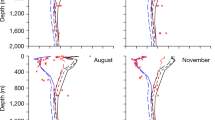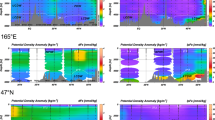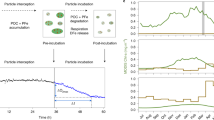Abstract
Hydrothermally sourced dissolved metals have been recorded in all ocean basins. In the oceans’ largest known hydrothermal plume, extending westwards across the Pacific from the Southern East Pacific Rise, dissolved iron and manganese were shown by the GEOTRACES program to be transported halfway across the Pacific. Here, we report that particulate iron and manganese in the same plume also exceed background concentrations, even 4,000 km from the vent source. Both dissolved and particulate iron deepen by more than 350 m relative to 3He—a non-reactive tracer of hydrothermal input—crossing isopycnals. Manganese shows no similar descent. Individual plume particle analyses indicate that particulate iron occurs within low-density organic matrices, consistent with its slow sinking rate of 5–10 m yr−1. Chemical speciation and isotopic composition analyses reveal that particulate iron consists of Fe(III) oxyhydroxides, whereas dissolved iron consists of nanoparticulate Fe(III) oxyhydroxides and an organically complexed iron phase. The descent of plume-dissolved iron is best explained by reversible exchange onto slowly sinking particles, probably mediated by organic compounds binding iron. We suggest that in ocean regimes with high particulate iron loadings, dissolved iron fluxes may depend on the balance between stabilization in the dissolved phase and the reversibility of exchange onto sinking particles.
This is a preview of subscription content, access via your institution
Access options
Access Nature and 54 other Nature Portfolio journals
Get Nature+, our best-value online-access subscription
$29.99 / 30 days
cancel any time
Subscribe to this journal
Receive 12 print issues and online access
$259.00 per year
only $21.58 per issue
Buy this article
- Purchase on Springer Link
- Instant access to full article PDF
Prices may be subject to local taxes which are calculated during checkout






Similar content being viewed by others
References
German, C. R. & Seyfried, W. E. in Treatise on Geochemistry Vol. 8 2nd edn (eds Holland, H. D. & Turekian, K. K.) 191–233 (Elsevier, 2014).
Sunda, W. G. Feedback interactions between trace metal nutrients and phytoplankton in the ocean. Front. Microbiol. 3, 204 (2012).
Tagliabue, A. et al. How well do global ocean biogeochemistry models simulate dissolved iron distributions? Glob. Biogeochem. Cycles 30, 149–174 (2016).
Field, M. P. & Sherrell, R. M. Dissolved and particulate Fe in a hydrothermal plume at 9°45′N, East Pacific Rise: slow Fe (II) oxidation kinetics in Pacific plumes. Geochim. Cosmochim. Acta 64, 619–628 (2000).
German, C. R., Campbell, A. C. & Edmond, J. M. Hydrothermal scavenging at the Mid-Atlantic Ridge: modification of trace element dissolved fluxes. Earth Planet. Sci. Lett. 107, 101–114 (1991).
Wu, J., Wells, M. L. & Rember, R. Dissolved iron anomaly in the deep tropical-subtropical Pacific: evidence for long-range transport of hydrothermal iron. Geochim. Cosmochim. Acta 75, 460–468 (2011).
Fitzsimmons, J. N., Jenkins, W. J. & Boyle, E. A. Distal transport of dissolved hydrothermal iron in the deep South Pacific Ocean. Proc. Natl Acad. Sci. USA 111, 16654–16661 (2014).
Resing, J. A. et al. Basin-scale transport of hydrothermal dissolved metals across the South Pacific Ocean. Nature 523, 200–206 (2015).
Noble, A. E. et al. Basin-scale inputs of cobalt, iron, and manganese from the Benguela–Angola front to the South Atlantic Ocean. Limnol. Oceanogr. 57, 989–1010 (2012).
Fitzsimmons, J. N. et al. Partitioning of dissolved iron and iron isotopes into soluble and colloidal phases along the GA03 GEOTRACES North Atlantic Transect. Deep-Sea Res. II 116, 130–151 (2015).
Nishioka, J., Obata, H. & Tsumune, D. Evidence of an extensive spread of hydrothermal dissolved iron in the Indian Ocean. Earth Planet. Sci. Lett. 361, 26–33 (2013).
Klunder, M. B., Laan, P., Middag, R., De Baar, H. J. W. & van Ooijen, J. C. Dissolved iron in the Southern Ocean (Atlantic sector). Deep-Sea Res. II 58, 2678–2694 (2011).
Hawkes, J. A., Connelly, D. P., Rijkenberg, M. J. A. & Achterberg, E. P. The importance of shallow hydrothermal island arc systems in ocean biogeochemistry. Geophys. Res. Lett. 41, 2013GL058817 (2014).
Klunder, M. B., Laan, P., Middag, R., de Baar, H. J. W. & Bakker, K. Dissolved iron in the Arctic Ocean: important role of hydrothermal sources, shelf input and scavenging removal. J. Geophys. Res. 117, C04014 (2012).
Yucel, M., Gartman, A., Chan, C. S. & Luther, G. W. Hydrothermal vents as a kinetically stable source of iron-sulphide-bearing nanoparticles to the ocean. Nat. Geosci. 4, 367–371 (2011).
Sands, C. M., Connelly, D. P., Statham, P. J. & German, C. R. Size fractionation of trace metals in the Edmond hydrothermal plume, Central Indian Ocean. Earth Planet. Sci. Lett. 319–320, 15–22 (2012).
Gartman, A., Findlay, A. J. & Luther, G. W. III Nanoparticulate pyrite and other nanoparticles are a widespread component of hydrothermal vent black smoker emissions. Chem. Geol. 366, 32–41 (2014).
Bennett, S. A. et al. The distribution and stabilisation of dissolved Fe in deep-sea hydrothermal plumes. Earth Planet. Sci. Lett. 270, 157–167 (2008).
Sander, S. G. & Koschinsky, A. Metal flux from hydrothermal vents increased by organic complexation. Nat. Geosci. 4, 145–150 (2011).
Hawkes, J. A., Connelly, D. P., Gledhill, M. & Achterberg, E. P. The stabilisation and transportation of dissolved iron from high temperature hydrothermal vent systems. Earth Planet. Sci. Lett. 375, 280–290 (2013).
Feely, R. A. et al. Hydrothermal plume particles and dissolved phosphate over the superfast-spreading southern East Pacific Rise. Geochim. Cosmochim. Acta 60, 2297–2323 (1996).
Boström, K., Peterson, M. N. A., Joensuu, O. & Fisher, D. E. Aluminum-poor ferromanganoan sediments on active oceanic ridges. J. Geophys. Res. 74, 3261–3270 (1969).
Lupton, J. Hydrothermal helium plumes in the Pacific Ocean. J. Geophys. Res. 103, 15853–15868 (1998).
Black, E. E., Buesseler, K. O., Pike, S. M., Lam, P. J. & Charette, M. A. 234Th Distribution along the Eastern Pacific GEOTRACES Transect and Implications for Export and Remineralization Fluxes of Carbon and TEIs Ocean Sciences Meeting, New Orleans, Louisiana. CT24A-0140 (2016).
Hautala, S. L. & Riser, S. C. A nonconservative β-spiral determination of the deep circulation in the Eastern South Pacific. J. Phys. Oceanogr. 23, 1975–2000 (1993).
Faure, V. & Speer, K. Deep circulation in the eastern South Pacific Ocean. J. Mar. Res. 70, 748–778 (2012).
Toner, B. M. et al. Preservation of iron(II) by carbon-rich matrices in a hydrothermal plume. Nat. Geosci. 2, 197–201 (2009).
Cowen, J. P., Massoth, G. J. & Baker, E. T. Bacterial scavenging of Mn and Fe in a mid- to far-field hydrothermal particle plume. Nature 322, 169–171 (1986).
Cowen, J. P., Massoth, G. J. & Feely, R. A. Scavenging rates of dissolved manganese in a hydrothermal vent plume. Deep-Sea Res. A 37, 1619–1637 (1990).
Nealson, K. H., Tebo, B. M. & Rosson, R. A. Occurrence and mechanisms of microbial oxidation of manganese. Adv. Appl. Microbiol. 33, 279–318 (1988).
Toner, B. M. et al. The Speciation of Particulate Iron and Carbon in the East Pacific Rise 15 °S Near-Field Hydrothermal Plume and Underlying Sediments AGU Fall Meeting (2014).
Dauphas, N. & Rouxel, O. Mass spectrometry and natural variations of iron isotopes. Mass Spectrom. Rev. 25, 515–550 (2006).
Wells, M. L. & Goldberg, E. D. Marine submicron particles. Mar. Chem. 40, 5–18 (1992).
Bennett, S. A. et al. Iron isotope fractionation in a buoyant hydrothermal plume, 5S Mid-Atlantic Ridge. Geochim. Cosmochim. Acta 73, 5619–5634 (2009).
Dideriksen, K., Baker, J. A. & Stipp, S. L. S. Equilibrium Fe isotope fractionation between inorganic aqueous Fe(III) and the siderophore complex, Fe(III)-desferrioxamine B. Earth Planet. Sci. Lett. 269, 280–290 (2008).
Morgan, J. L. L., Wasylenki, L. E., Nuester, J. & Anbar, A. D. Fe isotope fractionation during equilibration of Fe-organic complexes. Environ. Sci. Technol. 44, 6095–6101 (2010).
Bruland, K. W., Orians, K. J. & Cowen, J. P. Reactive trace metals in the stratified central North Pacific. Geochim. Cosmochim. Acta 58, 3171–3182 (1994).
Conway, T. M. & John, S. G. The cycling of iron, zinc and cadmium in the North East Pacific Ocean—insights from stable isotopes. Geochim. Cosmochim. Acta 164, 262–283 (2015).
Radic, A., Lacan, F. & Murray, J. W. Iron isotopes in the seawater of the equatorial Pacific Ocean: new constraints for the oceanic iron cycle. Earth Planet. Sci. Lett. 306, 1–10 (2011).
Gledhill, M. & Buck, K. N. The organic complexation of iron in the marine environment: a review. Front. Microbiol. 3, 69 (2012).
Dick, G. et al. The microbiology of deep-sea hydrothermal vent plumes: ecological and biogeographic linkages to seafloor and water column habitats. Front. Microbiol. 4, 124 (2013).
Bennett, S. A. et al. Dissolved and particulate organic carbon in hydrothermal plumes from the East Pacific Rise, 9°50′N. Deep-Sea Res. I 58, 922–931 (2011).
Honjo, S., Manganini, S. J., Krishfield, R. A. & Francois, R. Particulate organic carbon fluxes to the ocean interior and factors controlling the biological pump: a synthesis of global sediment trap programs since 1983. Prog. Oceanogr. 76, 217–285 (2008).
Verdugo, P. et al. The oceanic gel phase: a bridge in the DOM–POM continuum. Mar. Chem. 92, 67–85 (2004).
Fitzsimmons, J. N. et al. Dissolved iron and iron isotopes in the Southeastern Pacific Ocean. Glob. Biogeochem. Cycles 30, 1372–1395 (2016).
Goldberg, E. D. Marine Geochemistry 1. Chemical Scavengers of the Sea. J. Geol. 62, 249–265 (1954).
Koschinsky, A. & Hein, J. R. Uptake of elements from seawater by ferromanganese crusts: solid-phase associations and seawater speciation. Mar. Geol. 198, 331–351 (2003).
Völker, C. & Tagliabue, A. Modeling organic iron-binding ligands in a three-dimensional biogeochemical ocean model. Mar. Chem. 173, 67–77 (2015).
Parekh, P., Follows, M. J. & Boyle, E. Modeling the global ocean iron cycle. Glob. Biogeochem. Cycles 18, GB1002 (2004).
Revels, B. N., Zhang, R., Adkins, J. F. & John, S. G. Fractionation of iron isotopes during leaching of natural particles by acidic and circumneutral leaches and development of an optimal leach for marine particulate iron isotopes. Geochim. Cosmochim. Acta 166, 92–104 (2015).
Cutter, G. A. & Bruland, K. W. Rapid and noncontaminating sampling system for trace elements in a global ocean surveys. Limnol. Oceanogr. 10, 425–436 (2012).
Planquette, H. & Sherrell, R. M. Sampling for particulate trace element determination using water sampling bottles: methodology and comparison to in situ pumps. Limnol. Oceanogr. 10, 367–388 (2012).
Fitzsimmons, J. N. & Boyle, E. A. Assessment and comparison of Anopore and cross flow filtration methods for the determination of dissolved iron size fractionation into soluble and colloidal phases in seawater. Limnol. Oceanogr. 12, 244–261 (2014).
Conway, T. M., Rosenberg, A. D., Adkins, J. F. & John, S. G. A new method for precise determination of iron, zinc, and cadmium stable isotope ratios in seawater by double-spike mass spectrometry. Anal. Chim. Acta 793, 44–52 (2013).
Lam, P. J., Ohnemus, D. C. & Auro, M. E. Size-fractionated major particle composition and concentrations from the US GEOTRACES North Atlantic Zonal Transect. Deep-Sea Res. II 116, 303–320 (2015).
McDonnell, A. M. P. et al. The oceanographic toolbox for the collection of sinking and suspended marine particles. Prog. Oceanogr. 133, 17–31 (2015).
Kilcoyne, A. L. D. et al. Interferometer-controlled scanning transmission X-ray microscopes at the Advanced Light Source. J. Synchrotron Radiat. 10, 125–136 (2003).
Acknowledgements
We thank K. Forsch and A. Malinina for assistance with particulate metal digestions and R. Bu for mass spectrometry support; P. Lam for leading the McLane pump team and designing the filter manifold used for STXM sample collection; S. Rauschenberg, C. Parker, C. Zurbrick, L. Richards, D. Ohnemus and the McLane pump team for help sampling on the GP16 cruise; J. Helgoe and E. Townsend for assistance with sample processing for dissolved δ56Fe; D. Kilcoyne for STXM training and guidance, and R. Sims and B. Cron for beamtime support; and J. Moffett and G. Cutter for their cruise leadership on GP16, as well as the support of the officers and crew of the RV Thomas G Thompson. D. Ohnemus and B. Twining participated in data quality control discussions and intercalibration of the particulate metal measurements, and J. Resing, P. Sedwick and B. Jenkins provided access to their published dissolved Fe, Mn, and 3He data sets and participated in helpful conversations about our data interpretation. This work was funded by the National Science Foundation (OCE-1234827 to R.M.S. and C.R.G., OCE-1235248 to C.R.G., OCE-1232986 to B.M.T., and OCE-1649435 and OCE-1649439 to S.G.J.). The Advance Light Source is supported by the Director, Office of Basic Energy Sciences, of the US Department of Energy under contract No. DE-AC02-05CF11231.
Author information
Authors and Affiliations
Contributions
J.N.F. determined the digested particulate metal concentrations, led data interpretation, and wrote the manuscript. R.M.S., C.R.G. and B.M.T. co-proposed the particulate studies. R.M.S., S.L.N. and C.R.G. collected samples on the GP16 cruise (C.R.G. as Chief Scientist). S.G.J. and C.M.M. made the Fe isotope measurements. C.L.H. and B.M.T. made the synchrotron measurements. All authors helped to refine the interpretation and contributed to manuscript revisions.
Corresponding author
Ethics declarations
Competing interests
The authors declare no competing financial interests.
Supplementary information
Supplementary Information
Supplementary Information (PDF 730 kb)
Rights and permissions
About this article
Cite this article
Fitzsimmons, J., John, S., Marsay, C. et al. Iron persistence in a distal hydrothermal plume supported by dissolved–particulate exchange. Nature Geosci 10, 195–201 (2017). https://doi.org/10.1038/ngeo2900
Received:
Accepted:
Published:
Issue Date:
DOI: https://doi.org/10.1038/ngeo2900
This article is cited by
-
Nepheloid layer generation by gas eruption: unexpected experimental results
Journal of Oceanology and Limnology (2023)
-
Petrobactin, a siderophore produced by Alteromonas, mediates community iron acquisition in the global ocean
The ISME Journal (2022)
-
Potential use of engineered nanoparticles in ocean fertilization for large-scale atmospheric carbon dioxide removal
Nature Nanotechnology (2022)
-
Impact of high Fe-concentrations on microbial community structure and dissolved organics in hydrothermal plumes: an experimental study
Scientific Reports (2022)
-
The 79°N Glacier cavity modulates subglacial iron export to the NE Greenland Shelf
Nature Communications (2021)



